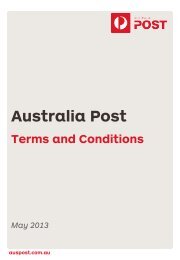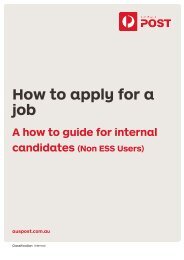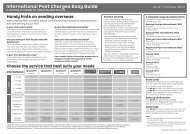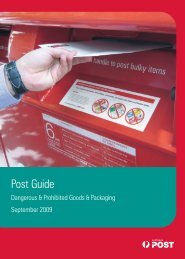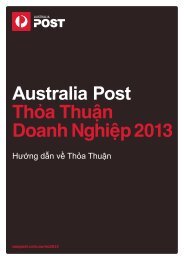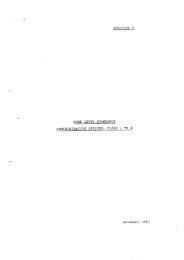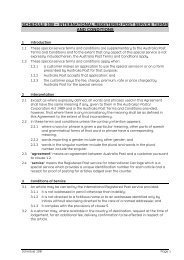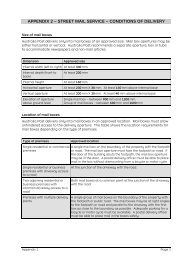2004-05 Annual Report - Australia Post
2004-05 Annual Report - Australia Post
2004-05 Annual Report - Australia Post
Create successful ePaper yourself
Turn your PDF publications into a flip-book with our unique Google optimized e-Paper software.
NOTES TO AND FORMING PART OF THE FINANCIAL STATEMENTS<br />
For non-specialised plant and equipment, fair value<br />
is established by reference to a market selling price<br />
where an active liquid market exists. Where no active<br />
liquid market exists but current evidence exists for<br />
similar assets, then fair value is determined using<br />
best available market evidence.<br />
(iii) Frequency of revaluation<br />
Freehold land and buildings have been revalued as at<br />
30 June 20<strong>05</strong>. Plant and equipment assets, including<br />
assets under finance leases, are recorded at fair value<br />
and are subject to annual review.<br />
(iv) Conduct of revaluations<br />
Revaluations of property assets are conducted by<br />
independent valuers.<br />
Revaluations of plant and equipment and leasehold<br />
improvements are at directors’ valuation and are subject<br />
to independent valuation at least every five years.<br />
(l) Intangibles<br />
Intangible assets comprise goodwill, customer<br />
contracts and computer software.<br />
Goodwill represents the excess of the purchase<br />
consideration over fair value of identifiable net assets<br />
acquired at the time of acquisition of a business or shares<br />
in an entity. Goodwill is amortised on a straight-line basis<br />
over the period during which benefits are expected to be<br />
received to a maximum of 20 years.<br />
Customer contracts acquired through the acquisition<br />
of a business are carried at allocated cost and amortised<br />
over the period during which the benefits are expected<br />
to be recovered to a maximum of 20 years.<br />
Computer software is carried at cost and is amortised<br />
on a straight-line basis over its anticipated useful life,<br />
being four to eight years.<br />
(m) Taxation<br />
The corporation is subject to all Federal, State and local<br />
government taxes and charges.<br />
Income tax has been brought to account using the<br />
liability method of tax effect accounting, whereby<br />
the income tax expense in the Statement of Financial<br />
Performance is matched with the accounting profit<br />
after allowing for permanent differences. Income tax<br />
on net cumulative timing differences is set aside to<br />
the deferred income tax and future income tax benefit<br />
accounts at the rates which are expected to apply<br />
when those timing differences reverse.<br />
Revenues, expenses and assets are recognised net of<br />
Goods and Services Tax (GST), except:<br />
° where the GST incurred on a purchase of goods<br />
and services is not recoverable from the taxation<br />
authority, in which case the GST is recognised<br />
as part of the cost of acquisition of the asset or<br />
as part of the expense item as applicable<br />
° receivables and payables are stated with the<br />
amount of GST included.<br />
Cash flows are included in the Statement of Cash<br />
Flows on a gross basis and the GST component of cash<br />
flows arising from investing and financing activities,<br />
which is recoverable from, or payable to, the taxation<br />
authority, are classified as operating cash flows.<br />
Tax consolidation<br />
The company and all its wholly owned <strong>Australia</strong>n<br />
FOR THE YEAR ENDED 30 JUNE 20<strong>05</strong><br />
resident entities are part of a tax-consolidated group<br />
under <strong>Australia</strong>n taxation law. The corporation is the<br />
head entity in the tax-consolidated group. Current<br />
and deferred tax balances of the members of the tax<br />
consolidated group are recognised in the financial<br />
statements of the corporation (as head entity in the<br />
tax consolidated group).<br />
Due to the existence of tax funding arrangements<br />
between the entities in the tax consolidated group,<br />
amounts are recognised as payable to or receivable<br />
by the corporation and each member of the group<br />
in relation to the tax contribution amounts paid or<br />
payable between the corporation and the other<br />
members of the tax-consolidated group in accordance<br />
with the arrangements.<br />
(n) Employee benefits<br />
(i) Benefits<br />
Liabilities for services rendered by employees are<br />
recognised at the reporting date to the extent that<br />
they have not been settled.<br />
Liabilities for wages and salaries (including non-monetary<br />
benefits) and annual leave are measured at their nominal<br />
amounts. Other employee benefits expected to be<br />
settled within 12 months of their reporting date are also<br />
measured at their nominal amounts.<br />
The nominal amount is calculated with regard to the<br />
rates expected to be paid on settlement of the liability.<br />
All other employee benefits expected to be settled<br />
beyond 12 months are measured as the present value of<br />
the estimated future cash outflows to be made in respect<br />
of services provided by employees up to the reporting<br />
date. The 10-year Commonwealth Government bond rate<br />
is used to discount these liabilities.<br />
(ii) Superannuation<br />
Generally the corporation meets its superannuation<br />
obligations (including those imposed under the<br />
Superannuation Guarantee (Administration) Act 1992)<br />
through the <strong>Australia</strong> <strong>Post</strong> Superannuation Scheme (APSS)<br />
and through the Superannuation Act 1976 (refer note 29).<br />
Amounts paid or payable by the corporation are<br />
charged to expense.<br />
(iii) Leave<br />
The liability for employee benefits includes provision<br />
for annual leave and long service leave. The liability<br />
for long service leave is established by reference to<br />
the work of an actuary as at balance date, with the<br />
estimate of present value taking into account attrition<br />
rates and pay increases through promotion and<br />
inflation. No liability for sick leave is recognised, as<br />
benefits lapse with termination of employment and<br />
experience indicates that the pattern of sick leave<br />
taken is less than the entitlement accumulating.<br />
(iv) Workers’ compensation<br />
The corporation is a licence holder under the Safety,<br />
Rehabilitation and Compensation Act 1988 (SRC Act).<br />
The corporation mostly self-insures its liability for<br />
workers’ compensation. Claims are recognised in the<br />
financial statements and measured by the discounted<br />
value of an annuity. The adequacy of the provision is<br />
established by reference to the work of an actuary as at<br />
balance date, with the estimate of present value taking<br />
into account pay increases, attrition rates, interest rates<br />
and the time over which settlement is made.<br />
<strong>Australia</strong> <strong>Post</strong> <strong>Annual</strong> <strong>Report</strong> <strong>2004</strong>/<strong>05</strong> Financial and Statutory <strong>Report</strong>s Notes to and forming part of the financial statements<br />
| 71 |




